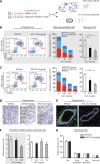Mammary molecular portraits reveal lineage-specific features and progenitor cell vulnerabilities
- PMID: 29921600
- PMCID: PMC6080920
- DOI: 10.1083/jcb.201804042
Mammary molecular portraits reveal lineage-specific features and progenitor cell vulnerabilities
Abstract
The mammary epithelium depends on specific lineages and their stem and progenitor function to accommodate hormone-triggered physiological demands in the adult female. Perturbations of these lineages underpin breast cancer risk, yet our understanding of normal mammary cell composition is incomplete. Here, we build a multimodal resource for the adult gland through comprehensive profiling of primary cell epigenomes, transcriptomes, and proteomes. We define systems-level relationships between chromatin-DNA-RNA-protein states, identify lineage-specific DNA methylation of transcription factor binding sites, and pinpoint proteins underlying progesterone responsiveness. Comparative proteomics of estrogen and progesterone receptor-positive and -negative cell populations, extensive target validation, and drug testing lead to discovery of stem and progenitor cell vulnerabilities. Top epigenetic drugs exert cytostatic effects; prevent adult mammary cell expansion, clonogenicity, and mammopoiesis; and deplete stem cell frequency. Select drugs also abrogate human breast progenitor cell activity in normal and high-risk patient samples. This integrative computational and functional study provides fundamental insight into mammary lineage and stem cell biology.
© 2018 Casey et al.
Figures










References
Publication types
MeSH terms
Substances
Grants and funding
LinkOut - more resources
Full Text Sources
Other Literature Sources
Medical
Molecular Biology Databases
Research Materials

